Malt in Homebrewed Beer: Introduction for Beginners
Published: July 19, 2025 at 9:45:05 PM UTC
When you're just starting your homebrewing journey, understanding the different types of malts can feel overwhelming. Yet malt is the soul of your beer – providing the fermentable sugars, distinctive flavors, and characteristic colors that define your brew. Think of malt as the flour in your beer recipe; it's the foundation upon which all other ingredients build. In this beginner-friendly guide, we'll explore the fascinating world of brewing malts, from the essential base malts that form the backbone of your beer to the specialty malts that add unique character. By the end, you'll have the knowledge to confidently select the right malts for your homebrewing adventures.
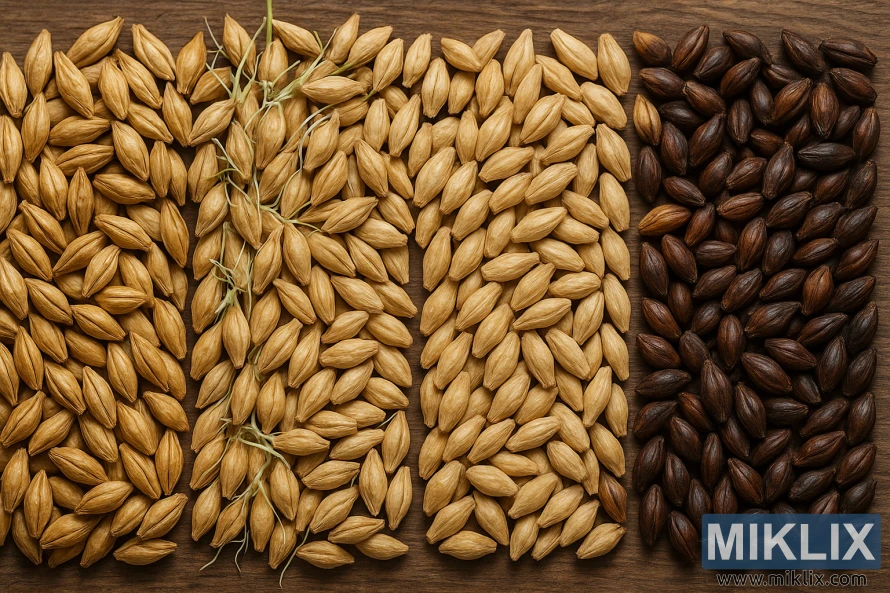
What is Malt?
Malt is grain (typically barley) that has undergone a controlled germination process called malting. During this process, the grain is soaked in water to trigger sprouting, which activates enzymes that convert the grain's starches into fermentable sugars. Once germination begins, the grain is dried and sometimes roasted to stop growth and develop specific flavors and colors. This transformation is what makes malt the perfect ingredient for brewing – it provides the sugars that yeast will later convert to alcohol during fermentation.
Types of Malt
Brewing malts generally fall into three main categories: base malts, specialty malts, and roasted/dark malts. Each category serves a different purpose in your beer recipe and contributes unique characteristics to your final brew.
Base Malts
Base malts are the foundation of your beer recipe, typically making up 60-100% of your grain bill. These malts have high enzymatic power, meaning they can convert their own starches into fermentable sugars during the mashing process. Think of base malts as the flour in your bread recipe – they provide the substance and structure.
| Base Malt Type | Color (Lovibond) | Flavor Profile | Common Usage | Beer Styles |
| Pale Ale Malt | 2.5-3.5°L | Mild, malty, slightly biscuity | 60-100% | Pale Ales, IPAs, Bitters |
| Pilsner Malt | 1.5-2.5°L | Light, clean, subtle | 60-100% | Pilsners, Lagers, Kölsch |
| Vienna Malt | 3-4°L | Toasty, malty, rich | 30-100% | Vienna Lagers, Märzen, Amber Ales |
| Munich Malt | 6-9°L | Rich, bready, toasty | 10-100% | Bocks, Oktoberfest, Dunkel |
For beginners, Pale Ale malt is an excellent starting point. It's versatile enough to serve as the foundation for many beer styles while providing a pleasant malty flavor. Pilsner malt is another beginner-friendly option, especially if you're brewing lighter beers where a clean, crisp character is desired.
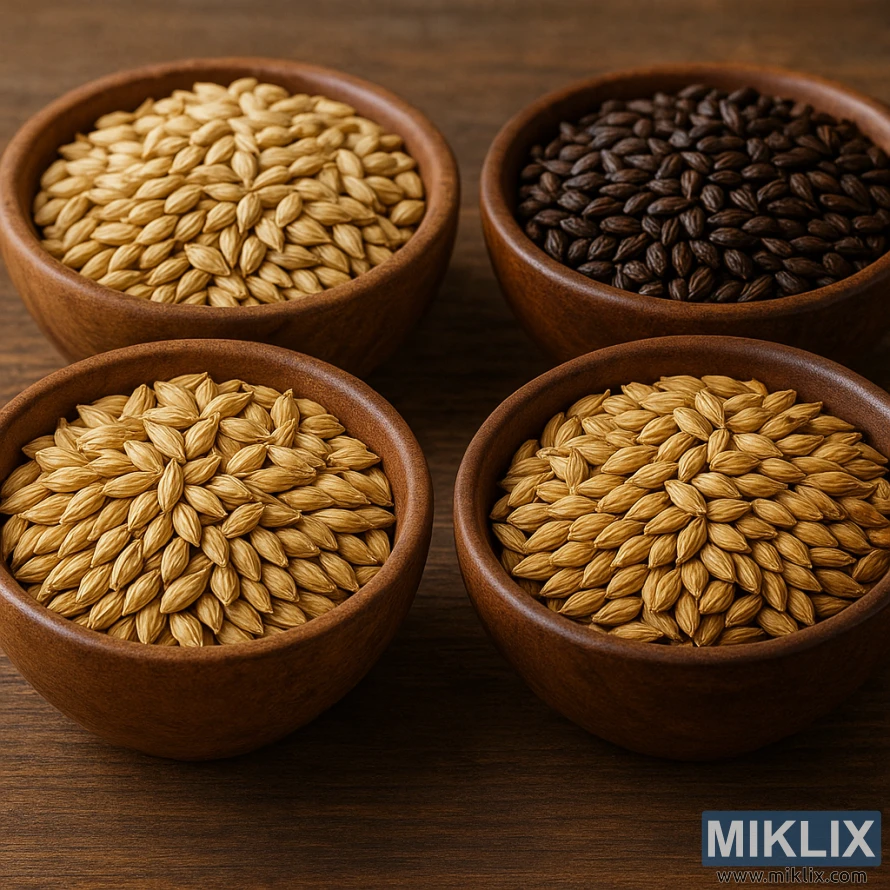
Specialty Malts
Specialty malts add complexity, body, and distinctive flavors to your beer. Unlike base malts, they typically make up a smaller percentage of your grain bill (5-20%) and have less enzymatic power. These malts are like the spices in your cooking – a little goes a long way in adding character.
Caramel/Crystal Malts
Caramel or crystal malts undergo a special process where the barley is heated while still moist, causing the starches to convert to sugars and caramelize inside the grain. These malts add sweetness, body, and amber to copper colors to your beer.
Available in various color intensities (10°L to 120°L), lighter caramel malts contribute subtle sweetness and golden hues, while darker varieties add rich toffee flavors and deeper amber colors. For beginners, Crystal 40L is a versatile choice that works well in many beer styles.
Other Specialty Malts
Beyond caramel malts, there are numerous specialty malts that can add unique characteristics to your beer:
- Wheat Malt: Enhances head retention and adds a soft, bready flavor
- Rye Malt: Contributes a spicy character and distinctive dryness
- Honey Malt: Adds a natural honey-like sweetness
- Biscuit Malt: Provides toasty, biscuit-like flavors
- Melanoidin Malt: Adds rich malty flavors and amber colors
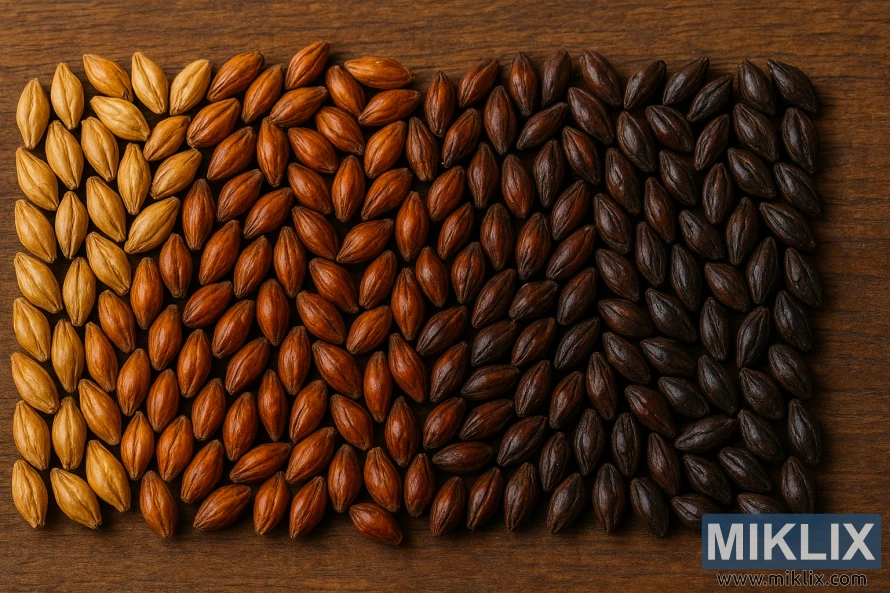
Roasted/Dark Malts
Roasted malts are the most intensely flavored and darkest of all malts. They're kilned at high temperatures, which develops strong flavors ranging from chocolate and coffee to burnt toast. These malts are used sparingly (1-10% of the grain bill) to add color and flavor complexity to darker beer styles.
| Roasted Malt Type | Color (Lovibond) | Flavor Profile | Recommended Usage | Beer Styles |
| Chocolate Malt | 350-450°L | Chocolate, coffee, roasty | 2-7% | Porters, Brown Ales, Stouts |
| Black Patent Malt | 500-600°L | Sharp, burnt, acrid | 1-3% | Stouts, Black IPAs |
| Roasted Barley | 300-500°L | Coffee, dry roastiness | 2-10% | Irish Stouts, Porters |
| Amber Malt | 20-30°L | Toasty, biscuity, nutty | 5-15% | Brown Ales, Porters, Milds |
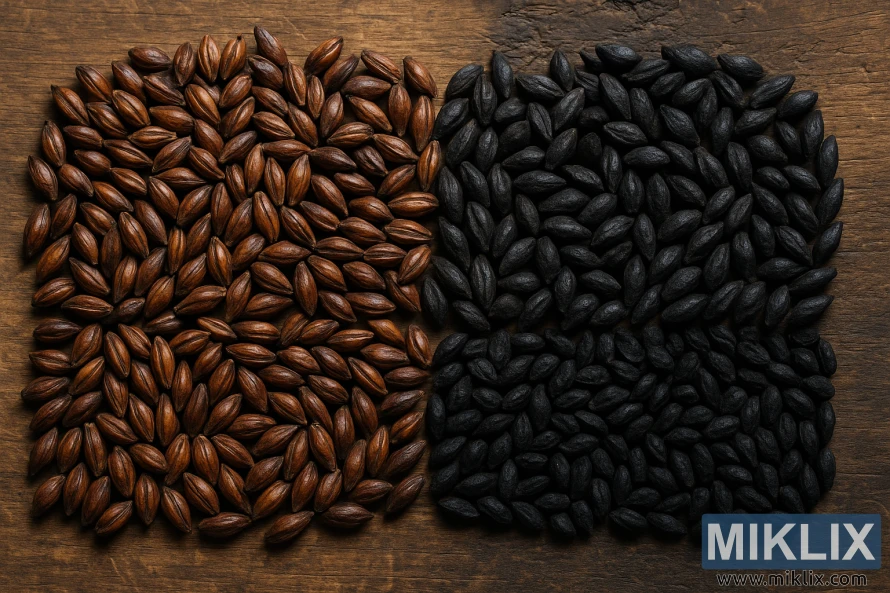
A common beginner mistake is using too much dark malt, which can make your beer harshly bitter or astringent. Start with small amounts (1-2% of your grain bill) and adjust based on your taste preferences.
Malt Comparison Chart
This chart compares the most common malts you'll encounter in homebrewing. Use it as a quick reference when planning your recipes or shopping for ingredients.
| Malt Name | Category | Color (Lovibond) | Flavor Notes | Recommended Usage | Best For |
| Pilsner | Base | 1.5-2.5°L | Light, clean, subtle | 60-100% | Light lagers, pilsners |
| Pale Ale | Base | 2.5-3.5°L | Mild, malty, biscuity | 60-100% | Pale ales, IPAs, most ales |
| Vienna | Base/Specialty | 3-4°L | Toasty, malty | 30-100% | Amber lagers, Vienna lagers |
| Munich | Base/Specialty | 6-9°L | Rich, bready, toasty | 10-100% | Bocks, Oktoberfest beers |
| Crystal 40L | Specialty | 40°L | Caramel, sweet | 5-15% | Amber ales, pale ales |
| Crystal 80L | Specialty | 80°L | Rich caramel, toffee | 3-10% | Brown ales, porters |
| Wheat Malt | Specialty | 2-3°L | Bready, soft | 5-60% | Wheat beers, improving head |
| Chocolate | Roasted | 350-450°L | Chocolate, coffee | 2-7% | Porters, stouts |
| Black Patent | Roasted | 500-600°L | Sharp, burnt | 1-3% | Stouts, color adjustment |
Choosing Malt for Homebrewing
Selecting the right malts for your homebrew can seem daunting at first, but with a few simple guidelines, you'll be crafting delicious beer in no time. Here are some practical tips for beginners:
Start with Simple Recipes
Begin your homebrewing journey with straightforward recipes that use just a few malt types. A good starting point is a simple pale ale with 90% pale ale malt and 10% crystal 40L. This combination provides a solid malty backbone with a touch of caramel sweetness.
As you gain experience, you can gradually experiment with more complex grain bills and specialty malts. Remember that even professional brewers often use relatively simple malt combinations to create world-class beers.
Consider Your Beer Style
Different beer styles call for different malt combinations. Research traditional grain bills for the style you want to brew:
- American Pale Ale: 90-95% Pale Ale malt, 5-10% Crystal 40L
- English Brown Ale: 80% Pale Ale malt, 10% Crystal 60L, 5% Chocolate malt, 5% Victory malt
- German Hefeweizen: 50-70% Wheat malt, 30-50% Pilsner malt
- Irish Stout: 75% Pale Ale malt, 10% Flaked Barley, 10% Roasted Barley, 5% Chocolate malt
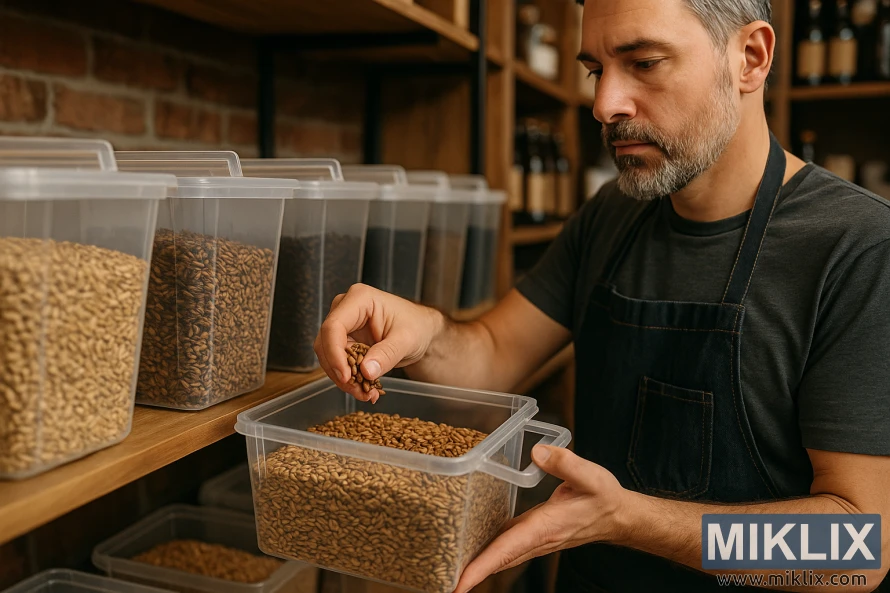
Experiment in Small Batches
One of the joys of homebrewing is the ability to experiment. Try brewing small one-gallon batches when testing new malt combinations. This allows you to explore different flavors without committing to a full five-gallon batch that might not turn out as expected.
Keep detailed notes about the malts you use and how they affect the final beer. This record will become invaluable as you develop your brewing skills and create your own recipes.
Consider Freshness and Storage
Malt quality significantly impacts your beer. Purchase from reputable suppliers who have good turnover, ensuring your malt is fresh. Once purchased, store your malts in airtight containers in a cool, dry place away from strong odors. Properly stored, whole malts can maintain their quality for 6-12 months.
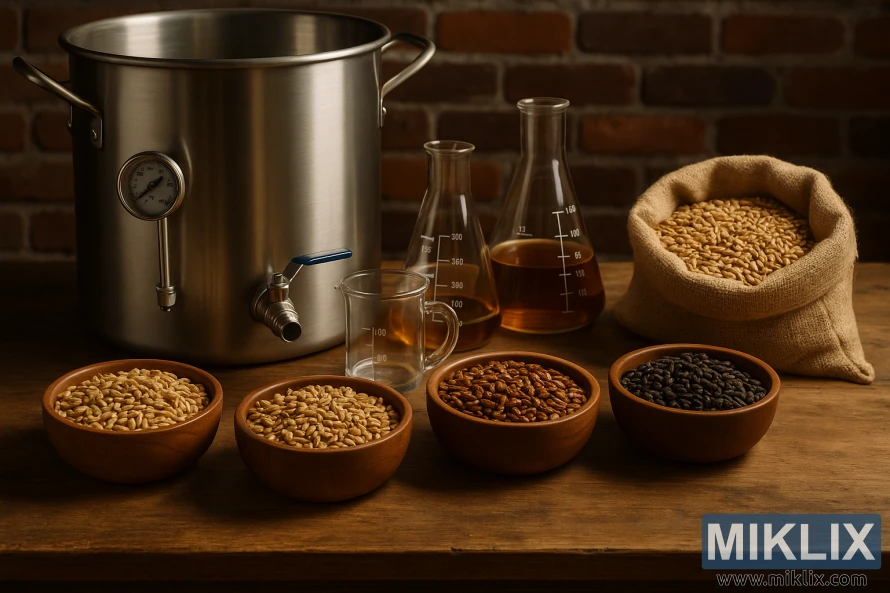
Common Malt Selection Mistakes
Best Practices
- Start with fresh, quality malts from reputable suppliers
- Use base malts as 60-100% of your grain bill
- Add specialty malts in small amounts (5-15%)
- Use dark roasted malts very sparingly (1-5%)
- Consider the water-to-grain ratio in your mash
- Keep detailed records of your recipes and results
Common Mistakes
- Using too much specialty malt (over 20%)
- Adding excessive dark malts, creating harsh flavors
- Ignoring mash pH (dark malts can lower pH significantly)
- Using stale or improperly stored malts
- Copying recipes without adjusting for your system
- Not considering how malts work together in combination
The most common mistake beginners make is using too much specialty malt, particularly dark roasted varieties. While it might be tempting to add significant amounts of chocolate or black malt to achieve a dark color, even small amounts (1-3% of your grain bill) can dramatically impact both color and flavor. Start with less than you think you need – you can always add more in your next batch.
Another important consideration is mash pH. Darker malts tend to lower the pH of your mash, which can affect enzyme activity and extraction efficiency. If you're using significant amounts of dark malt, you might need to adjust your water chemistry to compensate.
Beginner-Friendly Malt Recipes
Ready to put your new malt knowledge into practice? Here are three simple, beginner-friendly recipes that showcase different malt combinations:
Simple Pale Ale
Grain Bill (5 gallons):
- 9 lbs (90%) Pale Ale Malt
- 1 lb (10%) Crystal 40L
This straightforward recipe creates a balanced pale ale with a solid malt backbone and subtle caramel notes. It's an excellent first all-grain brew that demonstrates how even simple malt combinations can create delicious beer.
Amber Ale
Grain Bill (5 gallons):
- 8 lbs (80%) Pale Ale Malt
- 1 lb (10%) Munich Malt
- 0.75 lb (7.5%) Crystal 60L
- 0.25 lb (2.5%) Chocolate Malt
This amber ale recipe introduces a bit more complexity with Munich malt adding toasty notes, medium crystal malt providing caramel sweetness, and a touch of chocolate malt for color and subtle roast character.
Simple Porter
Grain Bill (5 gallons):
- 8 lbs (80%) Pale Ale Malt
- 1 lb (10%) Munich Malt
- 0.5 lb (5%) Crystal 80L
- 0.3 lb (3%) Chocolate Malt
- 0.2 lb (2%) Black Patent Malt
This porter recipe demonstrates how small amounts of dark malts can dramatically impact color and flavor. The combination creates a rich, complex beer with notes of chocolate, coffee, and caramel.
These recipes are just starting points. As you gain experience, feel free to adjust the proportions or substitute different malts to suit your taste preferences. Homebrewing is as much an art as it is a science, and experimentation is part of the fun!
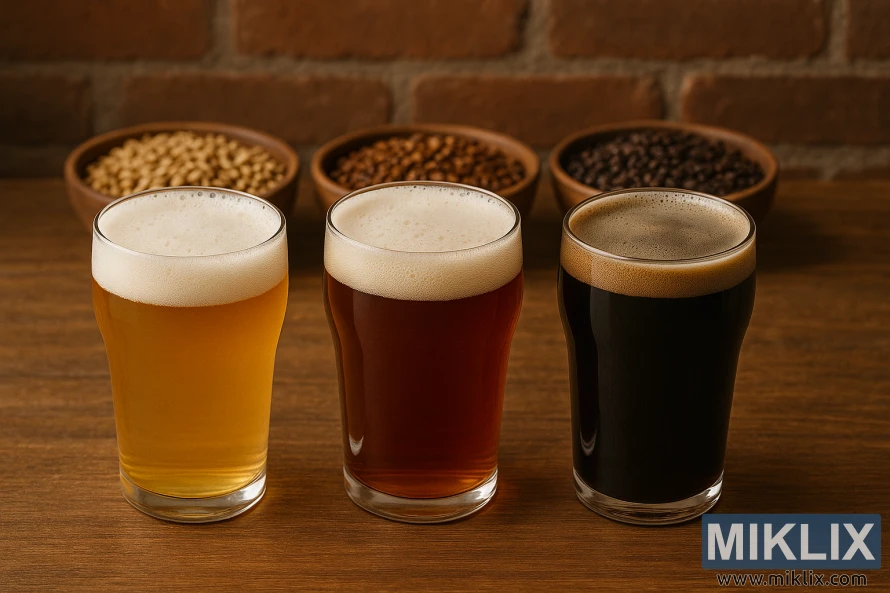
Conclusion
Understanding the different types of malts is a fundamental step in your homebrewing journey. From the essential base malts that provide fermentable sugars to the specialty and roasted malts that add complexity and character, each malt type plays a unique role in crafting your perfect beer.
Remember these key takeaways as you begin experimenting with malts:
- Base malts (Pale Ale, Pilsner) form the foundation of your beer and typically make up 60-100% of your grain bill
- Specialty malts (Crystal, Munich) add complexity and body, usually comprising 5-20% of your recipe
- Roasted malts (Chocolate, Black Patent) contribute deep colors and robust flavors, best used sparingly (1-10%)
- Start with simple recipes and gradually experiment with different malt combinations
- Keep detailed notes about the malts you use and how they affect your final beer
The world of brewing malts is vast and exciting, offering endless possibilities for creativity. Don't be afraid to experiment, but also respect the traditional knowledge that brewers have developed over centuries. With time and practice, you'll develop an intuitive understanding of how different malts interact and contribute to your homebrewed masterpieces.
Further Reading
If you enjoyed this post, you may also like these suggestions:
- Brewing Beer with Pale Chocolate Malt
- Brewing Beer with Special B Malt
- Brewing Beer with Golden Promise Malt
